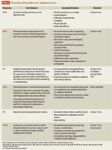Identifying anxiety disorders in the primary care setting
Anxiety is common in adolescents, who are often struggling to assert their identities at home, in school, and in social relationships. When significant anxiety impairs a teenager's ability to function normally, however, becoming familiar with the different diagnoses related to anxiety will help you decide whether treatment is necessary.

Key Points
All adolescents experience some degree of anxiety at some times in their lives. Teenagers typically worry about acceptance by peers and performance at school or in extracurricular activities.1,2
As they grow older, they also begin to develop concerns about more abstract and global issues, such as their future or the economy.3
For an important minority of adolescents, anxiety can become pervasive and cause extreme distress that affects their ability to function at home, at school, and socially.1-3
The overall prevalence rates of clinically significant anxiety disorders in children and adolescents combined have been found to be between 4% and 20%.1,2,4-6
In a large, nationally representative sample of children aged 13 to 18 years (National Comorbidity Survey Replication-Adolescent Supplement [NCS-A]) using a structured interview administered by trained lay interviewers, anxiety was found to be the most common mental disorder.7
Thirty-two percent of the sample (38% of girls; 26% of boys) met current diagnostic criteria for an anxiety disorder, including endorsement of impairment in daily activities or severe distress.
Only 18% of those adolescents received treatment, despite the increasing availability of effective treatments supported by a growing base of evidence.8
By developing increased familiarity with the diagnosis and treatment of anxiety disorders in this age group, it is hoped that more adolescents can be identified and appropriately treated.
Specific anxiety diagnoses in adolescents
By definition, any diagnosable anxiety disorder must cause significant distress or impairment.9
Several anxiety disorders seen in adolescents have key features in common, and the overlap of treatments for the various diagnoses is considerable.
In fact, generalized anxiety disorder (GAD), separation anxiety disorder (SAD), and social phobia (SP) are often studied together in clinical trials because of similarities in symptoms and treatments and because they often co-occur.6
